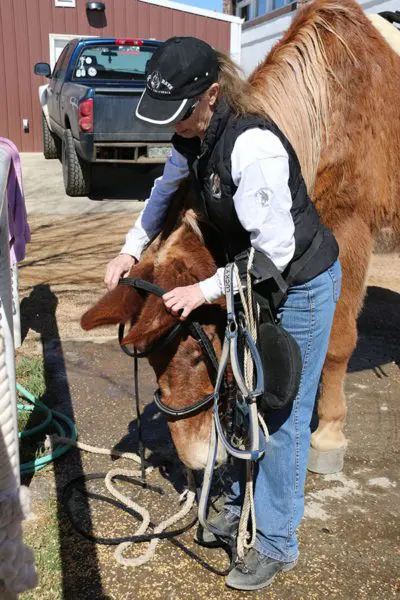
Mule and Donkey Training


MULE CROSSING: Owning an Equine Is Serious Business, Part 2
By Meredith Hodges
As discussed in Part 1 of this article, there are many realistic and very important steps to choosing, housing and caring for an equine. Let’s begin at the beginning … BEFORE you make a purchase.
TIP: Before you buy your equine, take the time to educate yourself with books and DVDs. Knowledge is your most powerful tool.
Here is a checklist of things to consider BEFORE you buy:
- Consult with knowledgeable professionals who can help you get started on the right foot.
- Pick your equine for not only his particular athletic potential, but for his compatibility with your own personality.
- Carefully choose your vet and farrier ahead of the time of your purchase.
- When you are ready to buy, bring along a qualified professional to look at any animals in which you may be potentially interested.
- When choosing your equine, ask the seller to demonstrate to you what the equine does, and then ask if you can ride him, doing the same moves yourself to make sure the animal will perform for more than just the seller.
- Check the animal for any unsoundness and signs of tranquilizers or other drugs.
- Ask the owner to load and unload the equine into and out of a trailer.
- Make sure registration papers and health records are in order and up to date.
- Get a pre-purchase exam from your veterinarian.
 Once your animal is home, make sure that:
Once your animal is home, make sure that:
- He has adequate shelter, good nutrition and a routine he can count on.
- There is a safely fenced, two-acre area per equine for turnout, along with adequate shelter from the elements.
- He is given feed that is appropriate for normal growth.
- Feeding is done at the same time each day, both in the morning and in the evening—without fail.
- You visit the barn twice every day in order to check your equine from head to tail, making sure that he has not injured himself and that he is not getting sick.
Become familiar with the first signs of possible illness:
- Is your equine eager to see you—alert and attentive, with bright eyes and ears perked in your direction—or is he sullen and lethargic?
- Does he go after his food immediately and chew with regularity?
- Does he appear to have been rolling on the ground? (If so, is he still eating well?)
- Is the manure a healthy color and consistency, and is there the usual amount of manure and urine? (If there is an abrupt change in amount or appearance, call your veterinarian.)
- Is your equine sweating? (If he is, is it just the weather, or is it an elevation in his temperature?)
- How is he moving? (Does he have regularity of gait, or is he exhibiting any lameness?)
- Check the eyes, ears and nostrils for discharge or any other irritations. (If there is any discharge, is it clear and minimal, or is it thick and yellowish or bloody?)
- Check the hooves for any cracks, stress rings or abnormalities in the foot. (How fast is the foot growing? Is the foot growing faster or slower than usual? Is he maintaining the proper angles in the feet? Prepare for farrier visits accordingly.)
- Check the water and trace mineral salt block. (Is the water clean and free from debris? Has the salt block been used? If so, how much?)
 To keep flies and other insects under control:
To keep flies and other insects under control:
- Feed the right kinds of healthy feed.
- Keep water sources clean and fresh.
- Daily—clean all stalls, pens and sheds so that they are free of manure, and add fresh bedding of straw or shavings, as needed.
- Periodically—clean your barn with a disinfectant.
- Keep all tack and equipment clean.
- Each time you leave the tack room, spray for any residual flies, using a household spray made specifically for flying insects.
- Keep manure collection piles well away from the barns and your house. (I suggest having manure hauled away weekly). Putting manure on pastures will only invite weeds to take over.
- Regularly groom once a week to remove excess hair, mud, etc. This will help to eliminate places on your animal (including his legs), that may be a target for egg-laying insects.
- For sores, scabs or bumps, use Neosporin. If these are severe, use Panalog—also called Animax or Dermalone—by prescription from your vet.
- Do not clip the hair inside the ears.
- Do not clip the hair on the legs (unless you absolutely must for showing).
- Use Johnson’s baby oil on the manes and tails.This helps to keep the flies at bay and will also keep other animals from chewing on each other’s manes and tails.
- Use Farnam brand Tri-Tech 14 fly spray once a week (it lasts the longest). This helps to control bugs and insects that can pester your equine, especially during warm weather. (I have found that herbal remedies do not seem to work as well.)
- Use fly masks that have holes for the ears for those equines that have sensitive skin and/or are sentive around the facial area. The fly masks that have ears built in often do not comfortably fit donkeys and mules.
Farnam Super Masks will usually fit most equines.You can find them in most tack and vet stores.
NOTE: To further prevent the infestation of parasites, fields and pastures should be harrowed in the spring and the fall, and between hay cuttings.
 Finding a good veterinarian and farrier is paramount to the health of your equine. You will need to find out which vaccinations are needed for your area, and schedule the spring vaccinations accordingly. If you are not a skilled, experienced equine person, it is best to have your veterinarian administer these vaccines for you, as sometimes certain animals can have adverse reactions to them. (Many inexperienced owners administer shots and other medications because they want to save money, but this can often result in adverse reactions and, consequentially, higher vet bills.)
Finding a good veterinarian and farrier is paramount to the health of your equine. You will need to find out which vaccinations are needed for your area, and schedule the spring vaccinations accordingly. If you are not a skilled, experienced equine person, it is best to have your veterinarian administer these vaccines for you, as sometimes certain animals can have adverse reactions to them. (Many inexperienced owners administer shots and other medications because they want to save money, but this can often result in adverse reactions and, consequentially, higher vet bills.)
Don’t be afraid to ask questions and encourage your veterinarian to help you to learn veterinary maintenance that you can do yourself. Most good veterinarians are happy to do this, as it frees them up to tend to the more serious cases in their practice. I would be suspicious of a vet who is reluctant to discuss the health of your equine with you.
Here’s a “health support team” checklist:
- Is the vet you are using allowing you to ask questions about your equine?
- Is he or she asking you questions about your equine, as well?
- Is there open communication between you and all the members of your equine’s support team?
- Do the vet, farrier, equine chiropractor, massage therapist and any other professionals involved in the welfare of your equine communicate well with each other?
NOTE: The overall focus should always be the health of the equine patient, including a cooperative effort from his health support team.
Now that you have a good idea of what it takes, on a daily basis, to properly manage your equine and his environment, you’re well on your way to reaching your goal of being a knowledgable, responsible equine owner. In Part 3 of this article, we will cover the responsibilities associated with your equine in preparation for future athletic activities.
To learn more about Meredith Hodges and her comprehensive all-breed equine training program, visit LuckyThreeRanch.com, MEREDITH HODGES PUBLIC FIGURE Facebook page, or call 1-800-816-7566. Check out her children’s website at JasperTheMule.com. Also, find Meredith on Pinterest, Instagram, MeWe, YouTube and Twitter.
Covered in TRAINING MULES & DONKEY: A LOGICAL APPROACH TO TRAINING, TRAINING WITHOUT RESISTANCE, EQUUS REVISITED and A GUIDE TO RAISING & SHOWING MULES at www.luckythreeranchstore.com.
© 2012, 2016, 2018, 2024 Lucky Three Ranch, Inc. All Rights Reserved.

MULE CROSSING: Keys To Successful Training, Part 1: Attitude and Approach
By Meredith Hodges
Establishing a bond – Are you having problems getting the same response from your equine that trainers do? This two-part article is designed to help you learn to successfully train your own equine.
 Training isn’t just a way to teach your equine to do certain “movements,” but a way for you to help him to grow physically and mentally healthy, and to enable him to learn to cope with the demands that will be put on him during his lifetime—much like raising a child to grow up to be a healthy and productive adult.
Training isn’t just a way to teach your equine to do certain “movements,” but a way for you to help him to grow physically and mentally healthy, and to enable him to learn to cope with the demands that will be put on him during his lifetime—much like raising a child to grow up to be a healthy and productive adult.
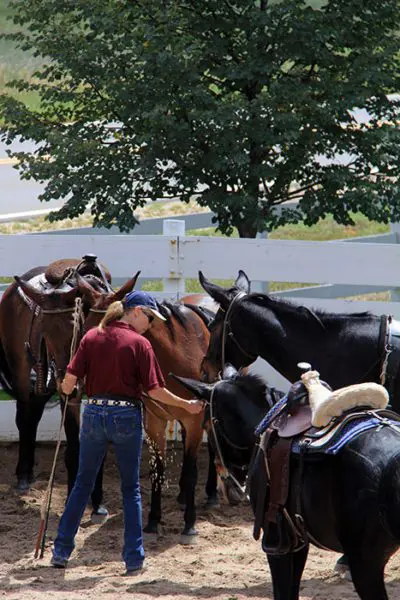 The subtleties in your attitude and approach, along with a solid knowledge base, can make all the difference in your training program. Whether your equine is a foal or an older animal that you have just obtained, whether he is trained or untrained, the process is the same and it’s never too late to get started with the right kinds of expectations in mind. You are creating a bond, developing the foundation for a healthy friendship, and setting the ground rules that will dictate the positive extent of your continuing relationship with your animal. It is important to be an active participant in your animal’s training. After all, you wouldn’t have someone else make a friend for you. You’d do it yourself—one-on-one.
The subtleties in your attitude and approach, along with a solid knowledge base, can make all the difference in your training program. Whether your equine is a foal or an older animal that you have just obtained, whether he is trained or untrained, the process is the same and it’s never too late to get started with the right kinds of expectations in mind. You are creating a bond, developing the foundation for a healthy friendship, and setting the ground rules that will dictate the positive extent of your continuing relationship with your animal. It is important to be an active participant in your animal’s training. After all, you wouldn’t have someone else make a friend for you. You’d do it yourself—one-on-one.
Feeding – What you feed your equine and how well his health is maintained will determine how responsive he will be to training. Although some popular feeds may build body mass more rapidly and may seem to be promoting healthy physical development, these high-protein feeds can also have negative effects, especially on Longears. Often, with high-protein feeds, an equine’s physical growth is accelerated and becomes disproportionate to his normal growth on simple equine feed like oats and grass hay. His mental growth may also be adversely affected with high-protein feeds, as they can cause anxiety and limited attentiveness. If the animal is feeling anxious or inattentive, or if parts of his body become sore from unnatural growth spurts or inappropriate exercise, he may be less likely to perform in an enthusiastic and energetic way.
I have found that equines do best on a mixture of crimped oats (1-2 lbs. for the average-sized saddle equine) mixed with a vitamin concentrate such as Sho-Glo (1 oz.), and Mazola corn oil (1 oz.) for hooves and coat, and for digestive tract regularity. Draft animals would get twice as much and minis get ¼ to ½ as much. This once-a-day oats mix regimen should be fed in the evenings and supplemented with grass hay twice a day, with the amount of hay being increased or decreased to monitor desired weight gain or loss. As a reward for positive responses in training, your animal should get the additional crimped oats so he will get immediate energy when he needs it the most, during the training process. Crimped oats, unlike any other equine reward, is also something that the animal will continue to work for without tiring of it.
Apples, carrots, horse treats and the like are things on which they can get sated and are not necessarily good for your equine in excess. Some of these “treats” can even have the same effect that candy has on children. An animal may experience residual affects such as an upset digestive tract, a short attention span or even hypertension, all of which can have a negative affect on training. Feeding the same way, and at the same times each day, is not only healthy, but it fosters confidence and trust within your animal because it makes him feel good. He learns without question that he can depend on you for his welfare and that his efforts will be rewarded with his favorite reward of crimped oats.
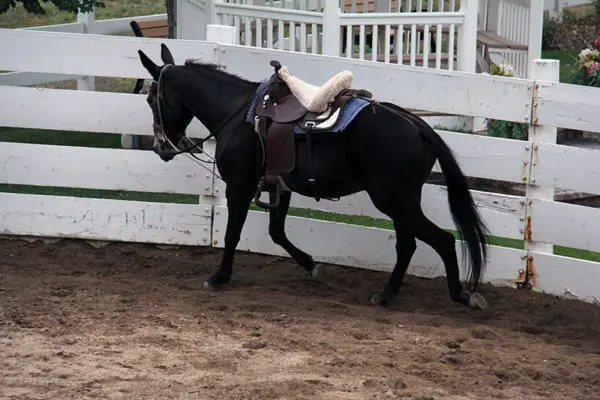 Consideration – Being patient, kind and considerate toward your equine and spending a little more time developing a good solid foundation with him before moving on to more elaborate maneuvers will yield better results. Remember to always be aware of your equine’s physical, mental and emotional responses during training. For instance, you may think that, once your mule is moving around the round pen at all three gaits with a reverse, he is ready to begin riding, but this may not necessarily be true. Considering that it takes years to really condition muscles to their maximum strength, six to eight months of doing round pen exercises is not really that long a period of time. If you don’t spend at least six months on flatwork leading training and six months on obstacle leading lessons to promote strength and balance in good posture, you can greatly hinder your equine’s ability to perform in the round pen on the circle. In turn, spending less than six to eight months in the round pen will not produce the best results in muscle development. If you move through conditioning too fast, it will affect your animal’s mental attitude toward training and he will very likely experience soreness and emotional depression. As a result, he will most likely become resistant to training.
Consideration – Being patient, kind and considerate toward your equine and spending a little more time developing a good solid foundation with him before moving on to more elaborate maneuvers will yield better results. Remember to always be aware of your equine’s physical, mental and emotional responses during training. For instance, you may think that, once your mule is moving around the round pen at all three gaits with a reverse, he is ready to begin riding, but this may not necessarily be true. Considering that it takes years to really condition muscles to their maximum strength, six to eight months of doing round pen exercises is not really that long a period of time. If you don’t spend at least six months on flatwork leading training and six months on obstacle leading lessons to promote strength and balance in good posture, you can greatly hinder your equine’s ability to perform in the round pen on the circle. In turn, spending less than six to eight months in the round pen will not produce the best results in muscle development. If you move through conditioning too fast, it will affect your animal’s mental attitude toward training and he will very likely experience soreness and emotional depression. As a result, he will most likely become resistant to training.
Pay attention to how many laps your equine does in each direction and at each gait: how many reverses to the left, and then how many to the right. Take this opportunity to assess whether he will need a few more laps on the side that is weaker. If you make these things your priority, when you finally do start riding him, his straight lines will be straighter, his turns smoother and his reverses and stops more balanced, and with minimal effort. As your equine grows stronger and more mentally and physically confident, the upper-level movements will come faster and easier than did the basic foundation training, which is why it’s so important to take your time and be patient—especially during foundation training. Another way to show consideration for your animal is to investigate valuable therapeutic tools like equine massage and chiropractics.
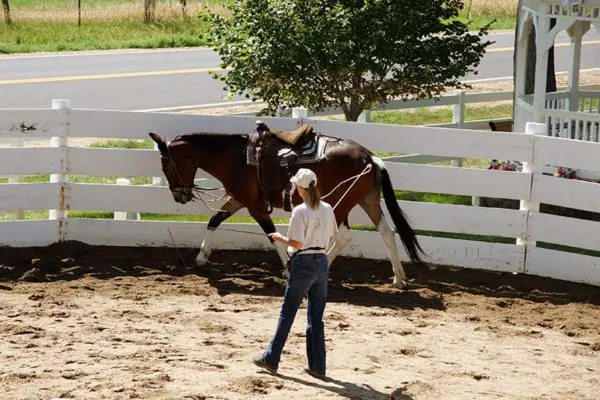 Structured exercises – Even if you do not plan to show your equine, he must be strong enough to be able to perform easily, even on something as seemingly simple as trail riding. Different exercises build different muscle groups, so it is important to know what exercises you should begin with and which exercises should follow. Don’t let yourself get sucked into drilling on something that just isn’t working. If you run into problems and things aren’t working out properly, just go back and try something that is similar in its demand but simpler for you and/or your equine to execute. Sometimes, it is just a manner of approaching the problem differently or leaving it to another day. Like humans, equines have their own individual ways of learning and it’s up to you to figure out what works best with your particular equine on any given day. You can find my suggested approaches to this in my DVD series, Training Mules & Donkeysand Equus Revisited. Note: Don’t forget to reward your animal for positive behavior.
Structured exercises – Even if you do not plan to show your equine, he must be strong enough to be able to perform easily, even on something as seemingly simple as trail riding. Different exercises build different muscle groups, so it is important to know what exercises you should begin with and which exercises should follow. Don’t let yourself get sucked into drilling on something that just isn’t working. If you run into problems and things aren’t working out properly, just go back and try something that is similar in its demand but simpler for you and/or your equine to execute. Sometimes, it is just a manner of approaching the problem differently or leaving it to another day. Like humans, equines have their own individual ways of learning and it’s up to you to figure out what works best with your particular equine on any given day. You can find my suggested approaches to this in my DVD series, Training Mules & Donkeysand Equus Revisited. Note: Don’t forget to reward your animal for positive behavior.
Body language and verbal communication – Learn to be consistent with your verbal commands and don’t leave them out. Most equines can learn to identify words and will usually respond much more readily to verbal commands than to cues alone, so give your equine this “verbal cue” advantage.
In the beginning, keep your words simple and consistent (“walk,” “trot,” “canter,” “reverse,” “whoa”). As your equine becomes more familiar with them, you can include additional words (“move over,” “go to the rail,” “easy,” and so forth). By the time he is an adult and has gone through this kind of training, he should begin to understand almost anything you might have to say. It is much like a child who first learns his ABCs, then words, then sentences and, eventually, entire paragraphs. Pay attention to yourself as you are training. How you feel affects your animal, which will dictate how he reacts to you. For instance, if you are a little nervous about being around your equine, he will sense this and may think there is a reason for him to be nervous, too. If you are happy, relaxed and patient about doing things, you will elicit a better response from your equine. Attitude is everything, so do whatever you need to do to keep the experience interesting and enjoyable for both of you.
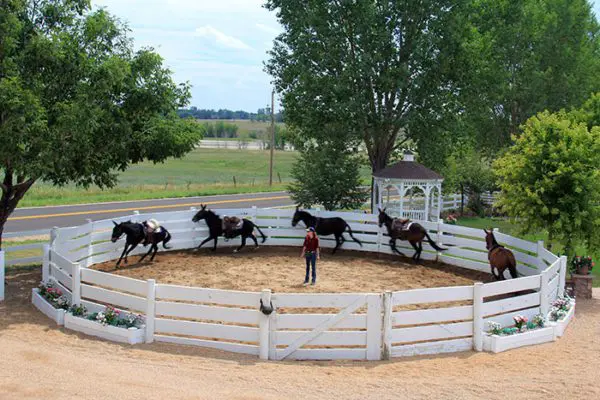 Benefits of group lessons – Equines can learn from each other, so it can be beneficial to work them together. When you are working with foals, it is helpful to take “Mom” along or have her tied nearby during training sessions. Green animals often do better on the trails during the first year if they are ridden along with well-trained trail animals. If you have multiple animals to keep conditioned, you can even lunge them together, provided your work in the round pen has been consistent with each of them separately from the beginning. In driving training, the “group lesson” idea of hitching young animals with the “old pros” has been a common practice for many years. Speaking of “old pros,” it is to your advantage to find a local instructor/trainer with whom you can periodically take lessons. This gives you a way to check to make sure you stay on the right track and continue to improve your own skills. Lists of trainers and instructors can be obtained from the United States Equestrian Federation and from the American Donkey & Mule Society. In Part 2 of Keys to Successful Training, I’ll go into further detail regarding ground training as well as the actual physical training areas, and many of the other important components that contribute to a successful and rewarding training program.
Benefits of group lessons – Equines can learn from each other, so it can be beneficial to work them together. When you are working with foals, it is helpful to take “Mom” along or have her tied nearby during training sessions. Green animals often do better on the trails during the first year if they are ridden along with well-trained trail animals. If you have multiple animals to keep conditioned, you can even lunge them together, provided your work in the round pen has been consistent with each of them separately from the beginning. In driving training, the “group lesson” idea of hitching young animals with the “old pros” has been a common practice for many years. Speaking of “old pros,” it is to your advantage to find a local instructor/trainer with whom you can periodically take lessons. This gives you a way to check to make sure you stay on the right track and continue to improve your own skills. Lists of trainers and instructors can be obtained from the United States Equestrian Federation and from the American Donkey & Mule Society. In Part 2 of Keys to Successful Training, I’ll go into further detail regarding ground training as well as the actual physical training areas, and many of the other important components that contribute to a successful and rewarding training program.
To learn more about Meredith Hodges and her comprehensive all-breed equine training program, visit LuckyThreeRanch.com, MEREDITH HODGES PUBLIC FIGURE Facebook page, or call 1-800-816-7566. Check out her children’s website at JasperTheMule.com. Also, find Meredith on Pinterest, Instagram, MeWe, YouTube and Twitter.
Covered in TRAINING MULES & DONKEY: A LOGICAL APPROACH TO TRAINING, TRAINING WITHOUT RESISTANCE and EQUUS REVISITED at www.luckythreeranchstore.com.
© 2004, 2005, 2013, 2016, 2018, 2024 Lucky Three Ranch, Inc. All Rights Reserved.



MULE CROSSING: Jack Copp and Joker
By Meredith Hodges
 Jack Copp was a very special man with a very special mule. Jack was born in Fairfax, Oklahoma, about 45 miles south of the Kansas border. His father worked with mules in the oil fields acquired
Jack Copp was a very special man with a very special mule. Jack was born in Fairfax, Oklahoma, about 45 miles south of the Kansas border. His father worked with mules in the oil fields acquired
from the Osage Indians by the U.S. Government years before. Although his father was familiar with mules, Jack was enamored with horses and particularly with team roping. Jack, a congenial and responsible man, worked at his job for 27 years and roped steers in his spare time.
Then came the accident that changed his life. Jack was run over by a forklift that left him partially crippled for the rest of his life. He could no longer do the things he loved the most. In the midst of his depression, he met an old man who suggested that he get a couple of mules to mess with. “They’ll git you on your feet,” he said. Jack took the man’s advice and bought Joker, a sorrel yearling mule colt, and his sister, Sissy, a weanling molly mule in November of 1978. By May of 1979, Jack had taught Joker enough tricks to entertain the audience at Bishop Mule Days in California.
 This was where I first saw them. In six short months Jack had Joker (only two years old) stretching, sitting, laying down, carrying his feed bucket, rolling a barrel with his front legs, and walking on his hind legs. What he had done with that handsome young mule was remarkable, but what Joker had done for Jack was even more amazing. Jack’s life was given new meaning and his faith restored by this long-eared, little red mule. Sissy, Joker’s sister, was sold and put into training with famed mule trainer Pat Parelli of California, while Jack and Joker became the very best of friends.
This was where I first saw them. In six short months Jack had Joker (only two years old) stretching, sitting, laying down, carrying his feed bucket, rolling a barrel with his front legs, and walking on his hind legs. What he had done with that handsome young mule was remarkable, but what Joker had done for Jack was even more amazing. Jack’s life was given new meaning and his faith restored by this long-eared, little red mule. Sissy, Joker’s sister, was sold and put into training with famed mule trainer Pat Parelli of California, while Jack and Joker became the very best of friends.
 Joker was sired by a Spanish jack, called Red Fox, that was killed by a hunter, and out of a Thoroughbred/Quarter Horse mare. He captured the hearts of all who were fortunate enough to witness his performances. The bond between Jack and Joker was evident as spectators delighted in watching a repertoire of 30 tricks or more. As Jack is a bashful man, Joker often had to push him into the arena to get things started. They began with a good stretch to loosen up the muscles and then Joker was ready to show his stuff. In top condition, Joker showed he could walk on three legs, then on two legs. This was pretty tough for a mule, but he did it out of love for Jack. Joker had no qualms about carrying his feed bucket to remind Jack of dinnertime. But Jack was a demanding trainer and concerned parent and made Joker earn his dinner by rolling a barrel with his front feet. When rolling the barrel forward became boring, Jack taught him to roll it backwards with his hind legs. As if this weren’t tough enough, Joker later learned to roll the barrel both backwards and forwards while straddling it! All this work is sometimes tiring, so Jack thought a short nap would be in order. Joker obliged his command by lying down–his rump made a handy seat for Jack to also take a rest.
Joker was sired by a Spanish jack, called Red Fox, that was killed by a hunter, and out of a Thoroughbred/Quarter Horse mare. He captured the hearts of all who were fortunate enough to witness his performances. The bond between Jack and Joker was evident as spectators delighted in watching a repertoire of 30 tricks or more. As Jack is a bashful man, Joker often had to push him into the arena to get things started. They began with a good stretch to loosen up the muscles and then Joker was ready to show his stuff. In top condition, Joker showed he could walk on three legs, then on two legs. This was pretty tough for a mule, but he did it out of love for Jack. Joker had no qualms about carrying his feed bucket to remind Jack of dinnertime. But Jack was a demanding trainer and concerned parent and made Joker earn his dinner by rolling a barrel with his front feet. When rolling the barrel forward became boring, Jack taught him to roll it backwards with his hind legs. As if this weren’t tough enough, Joker later learned to roll the barrel both backwards and forwards while straddling it! All this work is sometimes tiring, so Jack thought a short nap would be in order. Joker obliged his command by lying down–his rump made a handy seat for Jack to also take a rest.
 At coffee break time, Joker took his shorter rests in a sitting position. Considerate of Jack, as a best friend should be, Joker stretched, lowering his back so that Jack could reach the stirrup easily to mount. Joker knew that tires are for traveling, but his only use for one was to plant his front feet on it, traveling around it with his back feet; or to plant his back feet on it and travel around it with his front feet. At the “End of the Trail,’ Joker placed all four feet on the tire, exhibiting his excellent balance. Jack and Joker were patriotic Americans. Joker would fly the flag while walking on his hind legs. Then Jack would take the flag while Joker bowed to the audience in appreciation for the applause!
At coffee break time, Joker took his shorter rests in a sitting position. Considerate of Jack, as a best friend should be, Joker stretched, lowering his back so that Jack could reach the stirrup easily to mount. Joker knew that tires are for traveling, but his only use for one was to plant his front feet on it, traveling around it with his back feet; or to plant his back feet on it and travel around it with his front feet. At the “End of the Trail,’ Joker placed all four feet on the tire, exhibiting his excellent balance. Jack and Joker were patriotic Americans. Joker would fly the flag while walking on his hind legs. Then Jack would take the flag while Joker bowed to the audience in appreciation for the applause!
 Not limited only to tricks, Jack removed the bridle and showed people how well trained Joker really was. Without the bridle, Joker performed pleasure, reining patterns, and trail obstacles with ease. No whips, no spurs, no bats–it’s all done with patience and love that you can feel as you watch them. They were quite remarkable! Jack believed that training a mule is like raising a child. If you slap them, bang on them, or worse, they will have no respect.
Not limited only to tricks, Jack removed the bridle and showed people how well trained Joker really was. Without the bridle, Joker performed pleasure, reining patterns, and trail obstacles with ease. No whips, no spurs, no bats–it’s all done with patience and love that you can feel as you watch them. They were quite remarkable! Jack believed that training a mule is like raising a child. If you slap them, bang on them, or worse, they will have no respect.
Mules will either be afraid of you or fight back. Of course, discipline is in order on occasion, but you don’t have to keep doing it. Once Jack began training Joker, Joker was not allowed to run with other animals. Jack was his only close companion. Others never distracted Joker from his best friend, Jack! Jack and Joker have performed at county fairs and shows throughout the U.S. and they were both loved and appreciated wherever they went. The fees for these shows were minimal–just enough to cover their traveling expenses. What a privilege it was to witness this incredible pair!
To learn more about Meredith Hodges and her comprehensive all-breed equine training program, visit LuckyThreeRanch.com, MEREDITH HODGES PUBLIC FIGURE Facebook page, or call 1-800-816-7566. Check out her children’s website at JasperTheMule.com. Also, find Meredith on Pinterest, Instagram, MeWe, YouTube and Twitter.
Covered in TRAINING MULES & DONKEY: A LOGICAL APPROACH TO TRAINING, TRAINING WITHOUT RESISTANCE and EQUUS REVISITED at www.luckythreeranchstore.com.
© 1986, 2016, 2024 Lucky Three Ranch, Inc. All Rights Reserved.

LTR Training Tip #48: Preparation for Lunging
Is your equine ready to start lunging training? Ask yourself these questions before beginning.

LTR Training Tip #27: The Face Tie
Learn how to properly use the “face tie” restraint for your mule or donkey. This is a humane alternative to twitches, stocks and hobbles. This tie should NEVER be used with horses.

MULE CROSSING: Selecting a Trainer
 By Meredith Hodges
By Meredith Hodges
We have our animals professionally trained primarily to allow them to perform to the best of their ability, but once we have decided to put them into training we are faced with the dilemma of selecting a trainer. With mules, selection of the trainer is of the utmost importance due to his psychological makeup. Remember that your mule cannot learn from someone he doesn’t like, and mules do have their preferences!
So, where do you begin looking for a trainer? The best place to begin would probably be at a mule show – study the animals and see who is winning the performance classes. Talk with those owners if they do not do the training themselves. They will probably be able to put you in touch with someone who does. Other good sources for trainers are the various equine publications that are popular in your area. Trainers, as in any business, will usually post ads. If no trainers are listed as such, study the ranch ads and contact the ranch owners – they should be able to help.
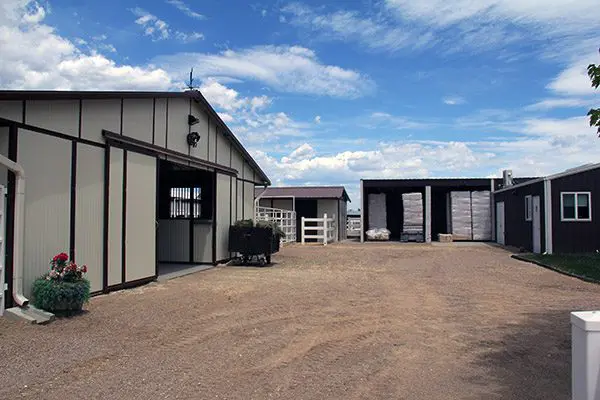 Once you have accumulated a few names, call and make appointments to visit the various trainers. The interview with the trainer is as important to you as it is to him. You will have an opportunity to discuss finance, goals and general care. An appointment will also give you the chance to see his facility and allow you to draw your own conclusions before you make a commitment. There are many good horse trainers available today, but they are not necessarily qualified to train mules. The mule trainer must be a person of extraordinary patience and be well versed in technique… and just as a precaution, you might ask if he’s ever trained a donkey. The mule trainer must know how to appeal to the donkey half of the mule as well as the horse half of the mule to be successful.
Once you have accumulated a few names, call and make appointments to visit the various trainers. The interview with the trainer is as important to you as it is to him. You will have an opportunity to discuss finance, goals and general care. An appointment will also give you the chance to see his facility and allow you to draw your own conclusions before you make a commitment. There are many good horse trainers available today, but they are not necessarily qualified to train mules. The mule trainer must be a person of extraordinary patience and be well versed in technique… and just as a precaution, you might ask if he’s ever trained a donkey. The mule trainer must know how to appeal to the donkey half of the mule as well as the horse half of the mule to be successful.
When you visit the trainer’s facility, there are several ways to get the information you require. First, pay attention to the general condition of the facility. Is it clean, free of debris with safe fencing? Check to see that water and mineral salt blocks are available to the stock. Does the trainer have a good working area available to him? In bad weather, an indoor arena is essential. If he does not have access to an indoor arena, he may not be able to work your mule as often as needed for a good sound training program. Next, check the general condition of his stock. Are they well fed? Are there any obtrusive scars or bruises on the animals, and what is the condition of their feet? Are they properly trimmed or shod? The condition of a trainer’s animals can tell you a lot about the trainer.
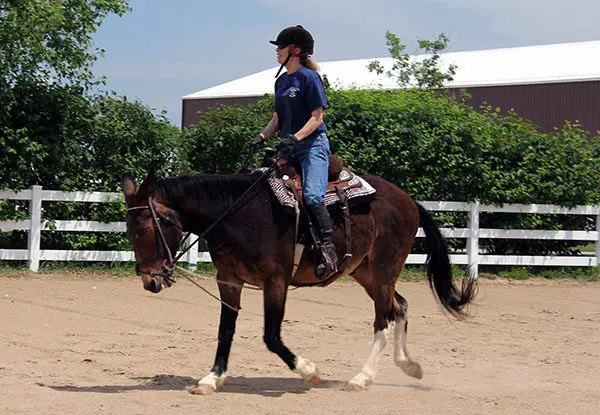 As a consideration to yourself and your mule, do not be afraid to ask the trainer if he will ride for you. You might want to mention the fact that you wish to see him ride at the time you make your appointment. The trainer can then be sure to allot the time necessary to ride for you. As he rides, watch the way he handles the animals. Are his hands light, yet firm? Does he ask for collection and cause the animal to travel smoothly and fluidly? Do his animals move away from leg pressure? Do the animals bend through their circles? Vertical flexion, impulsion, and lateral bend are all the elements of proper shape and any truly good trainer will know and practice these techniques. Beware of the person who claims to be a trainer, but only “rides” your animal. He could conceivably do immeasurable damage.
As a consideration to yourself and your mule, do not be afraid to ask the trainer if he will ride for you. You might want to mention the fact that you wish to see him ride at the time you make your appointment. The trainer can then be sure to allot the time necessary to ride for you. As he rides, watch the way he handles the animals. Are his hands light, yet firm? Does he ask for collection and cause the animal to travel smoothly and fluidly? Do his animals move away from leg pressure? Do the animals bend through their circles? Vertical flexion, impulsion, and lateral bend are all the elements of proper shape and any truly good trainer will know and practice these techniques. Beware of the person who claims to be a trainer, but only “rides” your animal. He could conceivably do immeasurable damage.
After touring the facility and watching the trainer at work, it is time for discussion. You have had a chance to determine the overall character of the trainer. If he is the least bit short-tempered or gruff, he is not trainer for your mule. If he seems patient and even-tempered, it is now time to discuss your goals and the way they will be financed. Be realistic about your expectations. An animal can be taught the basics in 60-90 days, but unless you are an experienced rider, the training cannot be maintained. Remember, training is primarily teaching the animal to respond to cues in a habitual manner and it takes time to build good habits. If you haven’t the finances for any more than 60-90 days and you are not experienced, ask the trainer if he would be willing to spend time in the last month, or so, teaching you how to ride your mule correctly. Any good trainer would insist that you do!
When you discuss your goals with the trainer, be concise and to the point. Ask him to clarify terms so that you understand exactly what he will be doing with your mule. Ask the trainer for a copy of the contract to take home with you and to study. To avoid any misunderstandings, ask the trainer about terms concerning the veterinarian, the horseshoer, hauling expenses, and any showing that you wish him to do. To clarify these responsibilities in advance will help to assure a good rapport with your prospective trainer.
If you are still unsure about a trainer after visiting his facility and talking with him, ask for references. While at home, you can check these references and go over the contract to see if he will, in fact, fit your needs.
Following these guidelines will enable you to locate the right trainer for your mule. Granted, it takes a little time to visit and discuss these things, but it is time well spent. The right trainer can produce a happy, healthy and well-mannered mule… but more than that, he can produce a satisfied owner!
To learn more about Meredith Hodges and her comprehensive all-breed equine training program, visit LuckyThreeRanch.com, MEREDITH HODGES PUBLIC FIGURE Facebook page, or call 1-800-816-7566. Check out her children’s website at JasperTheMule.com. Also, find Meredith on Pinterest, Instagram, MeWe, YouTube and Twitter.
Covered in TRAINING MULES & DONKEY: A LOGICAL APPROACH TO TRAINING, TRAINING WITHOUT RESISTANCE and EQUUS REVISITED at www.luckythreeranchstore.com.
© 1986, 1991, 2015, 2016, 2024 Lucky Three Ranch, Inc. All Rights Reserved.

CHASITY’S CHALLENGES: Soaking the Infection: 4-15-20 & 4-20-20
Chasity did not enjoy the soaking of her teats with the hose, so I opted to change my approach to make her more comfortable. Her posture has improved considerably with her postural core strength exercises in the “Hourglass Pattern” and with negotiating some of the obstacles to add coordination. She is now coming to the stall door to be haltered. She’s a very quick learner!


The infection is still draining and that is good. Each soaking, I groom her and scrape the discharge from her hind legs while she stands quietly.


I thought I might be able to make a “diaper” out of an old sheet to hold a wet towel wrapped around a hot pack instead of running a warm water hose underneath. First things first…I politely introduced her to the sheet, then began to wrap it around her!


This would solve two issues for me. She would not be aggravated with the water running down her legs and I wouldn’t be wasting water for ten minutes! She stood like a trooper while Chad and I wrapped the sheet into a useable position while Chasity looked on with a certain curiosity. “What do you think you are doing? Very odd things these people do!”


Once in place with the hot pack held in the sheet, we realized it was heavy and was pulling the sheet down, so I still had to stand there and hold up both sides to bring it up to her udder. At least I didn’t have to bend over! Chasity received her oats once again for being a trooper!


After ten minutes of soaking, Chad and I released the “diaper” carefully so as not to startle Chasity. We now knew what we would have to do to modify the “diaper” for future use.


Chasity had her first lesson in neck stretches after her soaking. This would be another aid in shrinking the fat roll over her neck…first to the left…and then to the right.


She was hesitant to do another stretch to the left, so I put her up against the hitch rail and tried again. She was still uncomfortable about doing a really good stretch, so I asked her to wrap her head around my waist. She complied and was amply rewarded for her efforts.


The next soaking on 4-20-20, I had the diaper modified and left the job to Steve and Bailey to execute to make sure that Chasity would accept help from everyone and not just me. Steve led her from the barn and cleaned the crust from her eyes.


Bailey began work scraping off the dried pus on her back legs with the shedding blade while Chasity stood quietly.


I had told Bailey that she might try giving Chasity a massage on her neck to see how she would tolerate it. She loved it!


I also asked Bailey to try using the massager on the infected area with only the hot pack (without the wet towel) to see if it would break up the infection in the hardened teats. The new “diaper” design worked like a charm! Unfortunately, the massager really didn’t make much of a difference on the hardened teats, so we will just use it on her neck and body going forward.


After the soaking, Greg Farrand, our vet called and told us the lab work was back. Chasity has a bacterial infection and not mastitis. She will be on antibiotics and daily soaking for quite some time. When she is done with the Uniprim, she will go on a second antibiotic regimen. As always, Chasity was generously rewarded for her compliance! She is such a dear donkey!


What’s New with Roll? Spring Grooming/Work in the Hourglass Pattern
Finally a day came that was warm enough to be able to wash the winter dirt out of Roll’s mane and tail! The first thing was to make sure he did not “feed on his lead rope” while I wasn’t looking, so I removed the rope lead and attached him to the chain lead at the wash rack.

The water was still icy cold, but I tried to limit his and my exposure to the cold. When we were done, his dirty brown mane and tail had turned the gorgeous, creamy reddish blond that I knew it was. He looked so handsome!
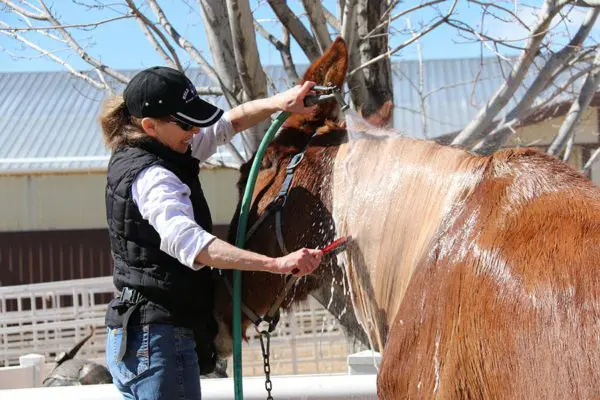
I gave his spine a stretch by pulling on his tail. Then it was time to put on his gear for his core strength leading exercises in the hourglass pattern in the outdoor arena.
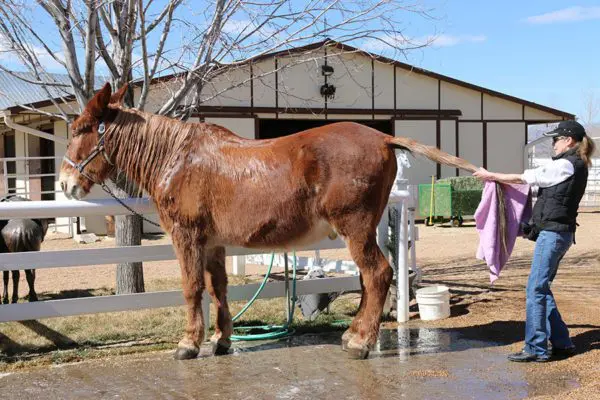
He put up with my fussing to fit the surcingle…

…and obediently dropped his head when I put on the bridle and “Elbow Pull.”
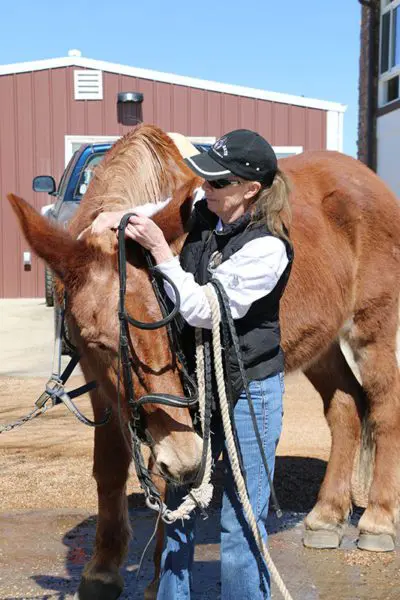
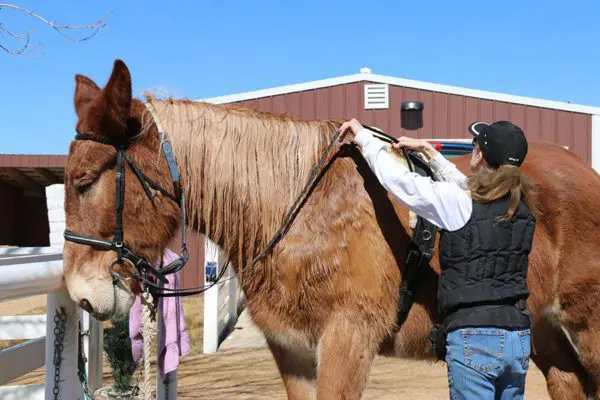
I think he was glad we were finally able to go back out and work again after a few weeks of VERY cold temperatures. He has been having difficulty getting up and down, so I new he needed to get back to some moderate forced exercise. When he is left to his own devices, he tends to be somewhat of a couch potato.
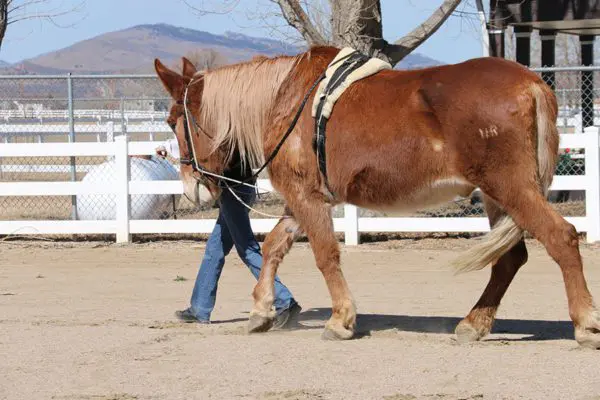
He actually did better than I thought he would first walking down the road to the arena…
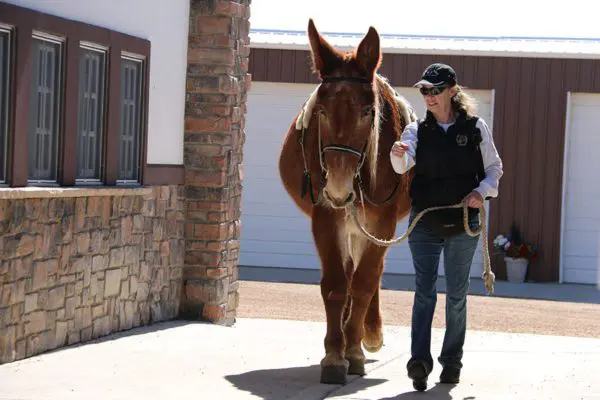
…and going through the gate to begin to execute the hourglass pattern balancing exercises.
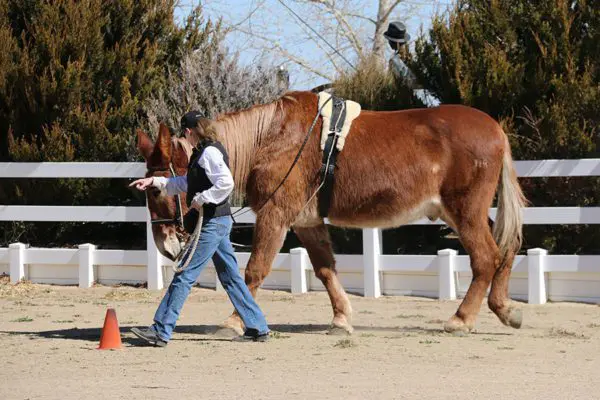
It wasn’t that hard to get him to set up his feet with equal weight over all four feet…easier than the last time. Still, he is hesitant to fully weight the right hind foot. I believe this might be due to the soreness that he has developed from getting up and down. He has pretty tall side bones in that foot.
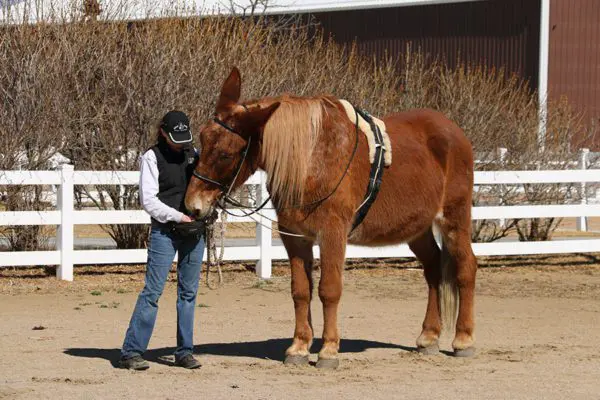
Roll is now 26 years old and although he cooperates, his mind does wander a bit like a “little old man’s” mind would! Still, when I call his name to remind him, he DOES come to attention!
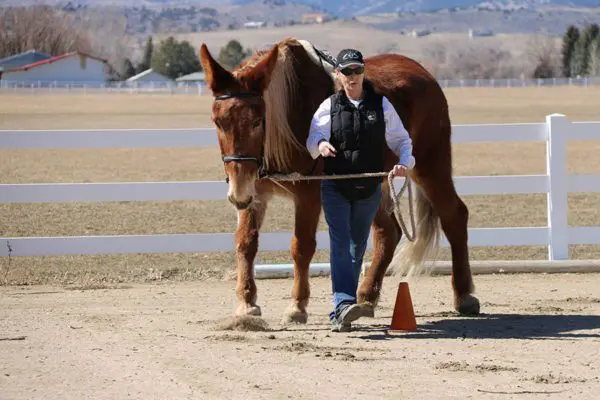
After we did the hourglass pattern 1 ½ times each way, I slung the lead rope over his neck for the first time to see if he would follow me across the arena to the gate, stop, through the gate and down the road to the Tack Barn (Sorry, no photos – we shot video). He did excellent! I was so proud!
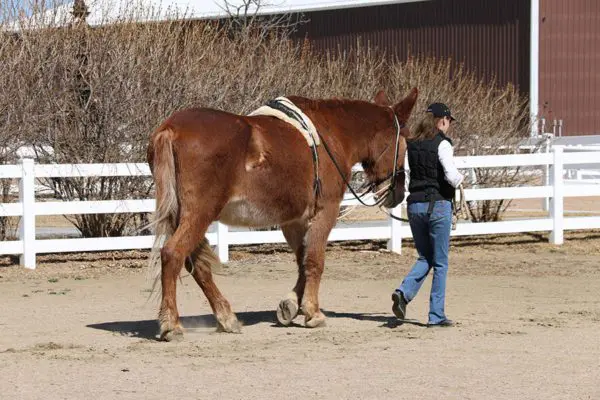
And when we got back, he obediently lowered his head again to get his bridle removed. He has truly changed dramatically in the eight years that I have had him. I can’t believe it has been that long! My how time flies when you’re having fun together…staying healthy!
